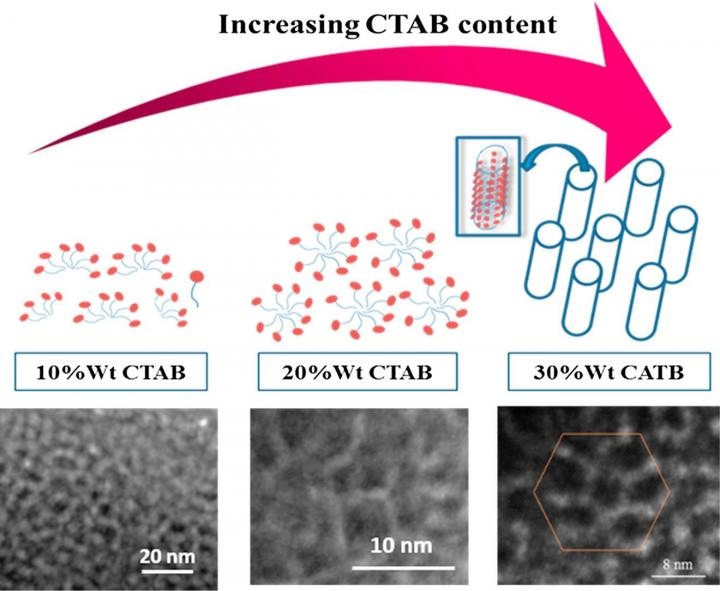Jan 24 2019
Researchers at the Far Eastern Federal University (FEFU), in collaboration with foreign and Russian colleagues, have created samples of nickel mesoporous film structures, which possess up to 400 times larger useful surface area when compared to their solid one.
 A schematic illustration of the formation of spherical and hexagonally arranged rod-like micelles at different concentrations of CTAB. (Image credit: FEFU press office)
A schematic illustration of the formation of spherical and hexagonally arranged rod-like micelles at different concentrations of CTAB. (Image credit: FEFU press office)
This latest material can find applications in the chemical industry, energy saving, and other practical fields. The results of the study have been reported in the Applied Surface Science journal.
Alexander Samardak, a principal investigator and an associate professor of the Computer Systems Department at the School of Natural Sciences of FEFU, states that the development of magnetic porous systems is a promising area, which is still explored inadequately. The structure of nanoporous materials is analogous to a typical sponge, which can hold considerable volumes of substance hence the useful surface area of the sponge is much greater than its size.
The pores we obtained are very small, 4-5 nanometers, but thanks to them the total surface area of the material is increased 400 times. These unique properties grant the wide potential application of the material. Using such materials, one can create filters for cleaning and adsorption of ultrafine magnetic particles, media for storing substances, in particular, for hydrogen engines, where fuel storage cells are needed. In the future, they may be applied in the production of solar and lithium-ion batteries, in nanoelectronics and the automotive industry.
Alexander Samardak, Associate Professor, Computer Systems Department, School of Natural Sciences, FEFU
The unique material is achieved by electrodepositing nickel particles on an artificial framework of a surfactant (SAS), which provides a structure of nanotube array made of micelles. Following electrodeposition, the framework dissolves in water, leaving behind mesoporous nickel alone. Researchers have found out that when a specific concentration of surfactants (30 weight percent) is used, the nickel frame structure does not grow in a random manner, but grows in the form of hexagonally ordered nanotubes. This unique property was detected using a high-resolution transmission electron microscope operated by Dr Alexey Ognev from FEFU. This paves way for further opportunities for this material application in the field of magnetic sensors and activators for nanoelectronics.
This research is the combined work of researchers from the laboratory of thin film technologies, Department of Physics of Low-Dimensional Structures of the School of Natural Sciences, FEFU, with researchers from Iran and Romania. Technoline Company (Vladivostok), which offered advanced equipment, supported the research process.
FEFU has a priority research project “Materials”, which is cooperated by a group of capable young chemists, physicists, materials scientists, and biologists. Till now, researchers have made considerable progress in developing new materials. Some of the exclusive developments are iron and cobalt nanosprings developed by researchers from the School of Natural Sciences and Korea University (Republic of Korea). With the integration of magnetic properties and the potential to maintain elasticity, they can be used to produce nanosensors, nanorobots, agents for targeted drug delivery, new types of memory, and other purposes.